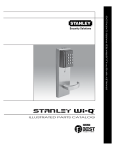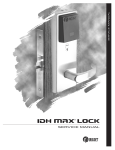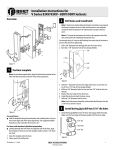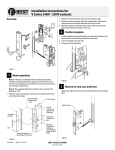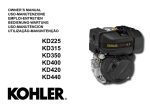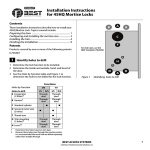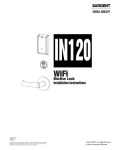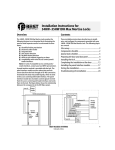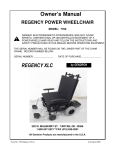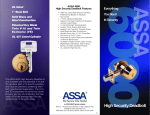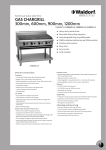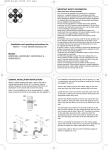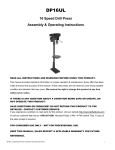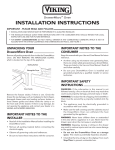Download Installation Instructions for Wi-Q™ Technology 9KQ Cylindrical Locks
Transcript
Installation Instructions for Wi-Q™ Technology 9KQ Cylindrical Locks Planning the installation Contents Components checklist These installation instructions describe how to install your 93KQ Cylindrical Lock. Topics covered include: Use the following checklist to make sure that you have the items necessary to install your Electronic Wireless Cylindrical Lock. Planning the installation ............................................... 1 Preparing the door and door jamb .............................. 2 Installing the lock ........................................................... 7 Completing the installation ........................................13 Patents Products covered by one or more of the following patents: 5,590,555 5,794,472 5,083,122 6,720,861 Site survey Use the following survey to record information about the installation site. You need this information to determine how to prepare the door for the lock. Door information Door handing and bevel: ❑ Left hand (LH) ❑ Left hand, reverse bevel (LHRB) ❑ Right hand (RH) ❑ Right hand, reverse bevel (RHRB) Door thickness: inches (1 3/4″ to 2 1/4″ ) Environment information Ambient temperature: ❑ Is within specifications. See the tables below. This product meets the following Locked Door Outdoor test requirements for ANSI/BHMA 156.25: Side of door Range Outside –31°F to +151°F (–35°C to +66°C) This product meets the following Full Indoor test requirements for ANSI/BHMA 156.25: Side of door Range Inside and out+32°F to +120°F (0°C to +49°C) side Components provided in the box: ❑ Chassis with outside lever and outside rose liner assembly ❑ Top and bottom inside covers ❑ Fire plate ❑ Battery holder with batteries ❑ Inside rose liner ❑ Outside escutcheon assembly ❑ Inside lever ❑ Throw member package ❑ Latch ❑ Hub washers ❑ Trim hole insert package ❑ Plastic bushing package ❑ Escutcheon screw package ❑ Door status switch assembly ❑ Strike package ❑ Bar code ID sticker (for your records) ❑ Installation template and instructions Other components: ❑ Core and control key ❑ Temporary operator card Special tools checklist Use the following checklist to make sure that you have the special tools necessary to install your Electronic Wireless Cylindrical Lock. ❑ KD303 Drill jig ❑ T20 TORX® bit driver ❑ KD325 Strike plate locating pin ❑ KD315 Faceplate marking chisel BEST ACCESS SYSTEMS a Product Group of Stanley Security Solutions, Inc. 1 Installation Instructions for Wi-Q™ Technology 9KQ Cylindrical Locks Preparing the door and door jamb 1 Installation template Position template and mark drill points Note: If the door is a fabricated hollow metal door, determine whether it is properly reinforced to support the lock. If door reinforcement is not adequate, consult the door manufacturer for information on proper reinforcement. For dimensions for preparing metal doors, see the Q01 and G02 Templates—Installation Specifications for 93KQ Cylindrical Locks. Note: If the door is a LH or RH door, mark the inside of the door. If the door is a LHRB or RHRB door, mark the outside of the door. For uncut doors and frames Centerline of lock 1 Measure and mark the horizontal centerline of the lever (the centerline for the chassis hole) on the door and door jamb. Mark the vertical centerline of the door edge. Note: The recommended height from the floor to the centerline of the crossbore or chassis hole is 38”. 2 Fold the Q05 Template—Installation Template for 93KQ Cylindrical Locks on the dashed line and carefully place it in position on the high side of the door bevel. Figure 1 Positioning the template Note: For steel frame applications, align the template’s horizontal centerline for the latch with the horizontal centerline of the frame’s strike preparation. 3 Tape the template to the door. 4 Center punch the necessary drill points. Refer to the instructions on the template. For doors with standard cylindrical preparation 1 Fold the Q05 Template—Installation Template for 93KQ Cylindrical Locks on the dashed line. Looking through the hole from the opposite side of the door, align the template so that you see the template outline of the 2 1/8″ diameter chassis hole. 2 Tape the template to the door. 3 Center punch the necessary drill points. Refer to the instructions on the template. 2 BEST ACCESS SYSTEMS a Product Group of Stanley Security Solutions, Inc. Installation Instructions for Wi-Q™ Technology 9KQ Cylindrical Locks Preparing the door and door jamb 2 Drill holes and mortise for latch face 1 Drill the holes listed below: ■ ■ ■ ■ ■ ■ ■ upper and lower trim holes ◆ 5/8″ diameter ◆ through door harness hole ◆ 3/4″ diameter ◆ through door motor wire hole ◆ 7/16″ diameter ◆ through door ◆ before drilling chassis hole chassis hole ◆ 2 1/8″ diameter ◆ through door ◆ after drilling motor wire hole latch hole ◆ 1″ diameter ◆ meets chassis hole door status switch hole ◆ 1″ diameter ◆ meets harness hole anti-rotational hole, see “Use drill jig to drill through-bolt holes” on page 5. ◆ 5/16” diameter ◆ through door Harness hole Door status switch hole Upper trim hole Anti-rotational hole Latch hole Chassis hole Motor wire hole Anti-rotational hole Lower trim hole Latch face mortise Inside of door Figure 2 Drilling holes and mortising for the latch face Note 1: To locate the center of a hole on the opposite side of the door, drill a pilot hole completely through the door. Note 2: For holes through the door, it is best to drill halfway from each side of the door to prevent the door from splintering. 2 Mortise the edge of the door to fit the latch face. 3 Drill the holes for the screws used to install the latch. BEST ACCESS SYSTEMS a Product Group of Stanley Security Solutions, Inc. 3 Installation Instructions for Wi-Q™ Technology 9KQ Cylindrical Locks Preparing the door and door jamb 3 Install latch 1 Install the latch in the door. Note: The latch tube prongs should be centered and should project into the chassis hole. 2 Check that the door swings freely. 4 Chassis hole Install door status switch and magnet 1 On the door jamb, mark the drill point for the 1″ diameter magnet hole. This hole should be directly opposite the door status switch reader harness hole when the door is closed. Location of latch tube prongs Latch 2 Drill a 1″ diameter hole for the magnet, at least 1 3/4″ deep. 3 Insert the magnet in the hole. Inside of door Figure 3 Installing the latch in the door 4 Insert the door status switch assembly into the door status switch hole in the edge of the door, feeding the connectors out the harness hole to the inside of the door, as shown in Figure 4. Harness hole Magnet Door status switch Door jamb Figure 4 4 Inside of door Installing the door status switch and magnet BEST ACCESS SYSTEMS a Product Group of Stanley Security Solutions, Inc. Installation Instructions for Wi-Q™ Technology 9KQ Cylindrical Locks Preparing the door and door jamb 5 Use drill jig to drill through-bolt holes 1 Press the drill jig (KD303) onto the door, engaging it with the latch tube prongs (see the close-up in Figure 5). Make sure the front edge of the jig is parallel with the door edge. 2 Drill the through-bolt holes (5/16″ diameter) halfway into the door. Drill upper through-bolt hole. 3 Turn over the drill jig and repeat steps 1 and 2 from the opposite side of the door. Note: Replace the drill jig after 10 door preparations. Latch tube prongs Drill lower through-bolt hole. Inside of door Figure 5 Installing the drill jig and drilling the through-bolt holes BEST ACCESS SYSTEMS a Product Group of Stanley Security Solutions, Inc. 5 Installation Instructions for Wi-Q™ Technology 9KQ Cylindrical Locks Preparing the door and door jamb 6 Install strike box and strike plate 1 In alignment with the center of the latchbolt, mortise the door jamb to fit the strike box and strike plate. 2 Drill the holes for the screws used to install the strike box and strike plate. Strike box Strike plate 3 Insert the strike box and secure the strike with the two screws provided. 4 Check the position of the deadlocking plunger against the strike plate. Caution: The deadlocking plunger of the latchbolt must make contact with the strike plate, as shown in Figure 6b. The plunger deadlocks the latchbolt and helps prevents someone from forcing the latch open when the door is closed. Door jamb Figure 6a Installing the strike box and strike plate Deadlocking plunger Strike plate Door jamb Figure 6b Aligning the deadlocking plunger with the strike plate 6 BEST ACCESS SYSTEMS a Product Group of Stanley Security Solutions, Inc. Installation Instructions for Wi-Q™ Technology 9KQ Cylindrical Locks Installing the lock 7 Remove outside lever or knob 1 Insert the control key into the core and rotate the key 15 degrees to the right. 2 Insert a flat blade screwdriver into the figure-8 core hole and into the lever. 3 Press the screwdriver blade in the direction of the arrow in Figure 7. Note: You cannot remove the lever if the screwdriver blade is inserted too far past the keeper. 4 Slide the lever or knob off of the sleeve. Lever keeper Insert screwdriver blade here. Figure-8 core hole Figure 7 Removing the outside lever Caution: Be careful that you do not disconnect the lever keeper spring. 8 Adjust for door thickness 1 Determine the door’s thickness. 2 Pull the rose locking pin and rotate the outside rose liner until the proper groove on the through-bolt stud lines up with the hub face. 2 1/4″ groove 2″ 1 3/4″ Hub face Motor wire Outside rose liner Figure 8 Throughbolt stud Rose locking pin Adjusting the rose liner for the door thickness BEST ACCESS SYSTEMS a Product Group of Stanley Security Solutions, Inc. 7 Installation Instructions for Wi-Q™ Technology 9KQ Cylindrical Locks Installing the lock 9 Retractor Latch tube prong Latch tailpiece From the outside of the door, insert the lock chassis into the 2 1/8″ chassis hole, routing the motor wire through the notch. Caution: Make sure that the latch tube prongs engage the chassis frame and that the latch tailpiece engages the retractor. Latch tube prong Chassis frame Notch Install lock chassis and engage retractor in latch Chassis Inside of door Figure 9 Installing the lock chassis and engaging the retractor in the latch 10 Install the trim hole insert, bushing, and hub washer on outside of door 1 On the outside of the door, insert the trim hole insert into the upper trim hole, as shown in Figure 10. Trim hole insert Bushing 2 Insert the bushing into the harness hole. 3 Slide a hub washer over the chassis sleeve so it rests on the hub. Hub Hub washer Outside of door Figure 10 Installing the outside trim hole insert, bushing, and hub washer 8 BEST ACCESS SYSTEMS a Product Group of Stanley Security Solutions, Inc. Installation Instructions for Wi-Q™ Technology 9KQ Cylindrical Locks Installing the lock 11 Install fire plate Position the fire plate on the inside of the door so that the chassis fits through the square opening in the fire plate, as shown in Figure 11. Fire plate Inside of door Figure 11 Installing the fire plate 12 Install through-bolts and inside rose liner 1 Place the inside rose liner on the chassis, aligning the holes in the rose liner with the holes prepared in the door, as shown in Figure 12. Caution: Make sure that the motor wire is pulled Motor wire toward the top of the fire plate and avoid routing it over any surface that could damage the sleeving or wire insulation. RQE connector Rose liner with RQE 2 Install the through-bolts through the rose liner and door in the top and bottom holes. Through-bolt Caution: Make sure that there is clearance for the motor wire between the rose liner and the door. 3 Tighten the rose liner to the door and fire plate with the through-bolts. Inside of door 4 Install the hub washer over the rose liner. Hub washer Figure 12 Installing the through-bolts and rose liner (9K shown) BEST ACCESS SYSTEMS a Product Group of Stanley Security Solutions, Inc. 9 Installation Instructions for Wi-Q™ Technology 9KQ Cylindrical Locks Installing the lock 13 RQE connector Harness hole Battery connector Motor connector Door status connector Antenna wire RQE connector Route wire harness and position outside escutcheon 1 From the outside of the door, feed the motor connector, battery connector, door status switch, and antenna wire, through the harness hole. Caution: When routing the connectors, make sure the wire harness is not routed across any sharp edges or over any surface that could damage its sleeving or wire insulation. 2 On the inside of the door, insert the two countersunk mounting screws into the holes at the top and bottom of the fire plate. Outside escutcheon 3 Tighten the mounting screws until the fire plate is securely mounted to the door. Outside of door Figure 13 Feeding the wire harness connectors through the harness hole 14 Route wires on fire plate 1 Route the motor connector wire, RQE connector, and door status connector underneath the side tabs as shown in Figure 14. Antenna wire 2 Route the battery connector and antenna wire above the side tabs. See Figure 15 for additional detail. Battery connector Door status connector Side tabs Door status connector RQE connector Motor connector Inside of door Figure 14 Routing the wires on the fire plate 10 BEST ACCESS SYSTEMS a Product Group of Stanley Security Solutions, Inc. Installation Instructions for Wi-Q™ Technology 9KQ Cylindrical Locks Installing the lock 15 Connect motor wires, RQE, and door status switch 1 From the inside of the door, make the following connections: ◆ ◆ ◆ Battery connector Antenna wire Motor RQE Door status switch Wire connection Color Motor RQE Door status Yellow-Gray Orange-Brown White No. of wires 2 2 2 No. of pins 2 3 2 2 Insert the plastic wire tie through the mounting clip and secure the wires as shown in Figure 15. See Figure 15 for additional detail. Caution: When making the motor connection, Route wire harness on the left side of the fire plate. Mounting clip and wire tie make sure: ◆ there are no loose wire connections where the wires are inserted into the connectors ◆ the connectors are firmly mated. Dress wires so that wire connectors are mated here. Use electric tape to affix them as needed. Figure 15 Routing the wires (view of the inside escutcheon) BEST ACCESS SYSTEMS a Product Group of Stanley Security Solutions, Inc. 11 Installation Instructions for Wi-Q™ Technology 9KQ Cylindrical Locks Installing the lock 16 Install bottom cover (inside escutcheon) 1 Making sure that the cover does not pinch the wires, guide the bottom cover over the chassis onto the fire plate. 2 Use two cover screws to secure the cover to the side of the fire plate, as shown in Figure 16. Bottom cover Cover screws Note: Phillips Type 2 and T20 Torx options are available for the cover mounting screws. Caution: Dress all wires away from possible pinch points before putting the bottom cover in place. Inside of door Figure 16 Installing the bottom cover Battery holder 17 Antenna 1 Position the battery wires against the fire plate side wall, as shown in Figure 17. Battery wires Fire plate side tabs Battery holding tabs Install battery holder 2 Slide the battery holder behind the fire plate side tabs until it rests on the bent battery holding tabs. Caution: When routing the battery wires, make sure the wires are not routed across any sharp edges or over any surface that could damage their sleeving or wire insulation. 3 Connect the battery holder to the battery connector on the wire harness. Caution: When connecting the battery holder, Inside of door make sure: ◆ there are no loose wire connections where the wires are inserted into the connectors. ◆ the connectors are firmly mated. Figure 17 Installing the battery holder, eight-cell 12 BEST ACCESS SYSTEMS a Product Group of Stanley Security Solutions, Inc. Installation Instructions for Wi-Q™ Technology 9KQ Cylindrical Locks Completing the installation 18 Install inside and outside levers Note: To use a core and throw member from a manufacturer other than BEST with a Electronic Stand-alone Lock, see the Installation Instructions for 9K Non-interchangeable Cores & Throw Members (T56093) and skip task 19. ■ With the handle pointing toward the door hinges, position a lever on the outside sleeve and push firmly on the lever until it is seated. Repeat, placing the other lever on the inside sleeve. 19 Install core and throw member Outside of door 1 Install the blocking plate onto the throw member. Figure 18 Installing the levers Caution: You must use the blocking plate to prevent unauthorized access. For 6-pin core users only: Install the plastic spacer (not shown, supplied with permanent cores) instead of the blocking plate, on the throw member. Core 2 Insert the control key into the core and rotate the key 15 degrees to the right. Blocking plate 3 Insert the throw member into the core. Throw member 4 Insert the core and throw member into the lever with the control key. 5 Rotate the control key 15 degrees to the left and withdraw the key. Caution: The control key can be used to remove cores and to access doors. Provide adequate security for the control key. Figure 19a Installing the blocking plate and throw member Throw member Core Control key Figure 19b Installing the core BEST ACCESS SYSTEMS a Product Group of Stanley Security Solutions, Inc. 13 Installation Instructions for Wi-Q™ Technology 9KQ Cylindrical Locks Completing the installation 20 Antenna wire Install top cover (inside escutcheon) 1 Connect the antenna to its mating connector. 2 Place the top cover against the door and above the fire plate. Slide the top cover down toward the bottom cover as shown in Figure 20b. Top cover Caution: As you slide the top cover onto the fire plate, feed the antenna wire down into the bottom cover. Be sure not to pinch the antenna wire on the bottom cover as you slide the top cover into place. 3 Use two cover screws to secure the cover to the side of the fire plate, as shown in Figure 20b. Figure 20a Inside view of top cover Note: Phillips Type 2 and T20 Torx options are available for the cover mounting screws. Cover screws Top cover Antenna wire Inside of door Figure 20b Installing the top cover 14 BEST ACCESS SYSTEMS a Product Group of Stanley Security Solutions, Inc. Installation Instructions for Wi-Q™ Technology 9KQ Cylindrical Locks Completing the installation 21 Test lock For 9KQ Locks with keypad: To test the lock for proper operation before the lock is programmed, follow these instructions: 1 Press 1234. 2 Press #. The green light flashes and the locking mechanism unlocks. 3 Turn the lever and open the door. For all other locks: To test the lock for proper operation before the lock is programmed, use the temporary operator card that came with the lock. This card is for temporary use only. After permanent cards have been programmed for the lock, the temporary card should be deleted. If the mechanism doesn’t unlock, refer to the following table. For additional troubleshooting instructions, see the Service Manual. LEDs Sounder You should Single red flash — Use the card at a moderate speed. Red flashes 3 short tones Use the temporary operator card provided with the lock. Green flashes — Check the motor connection. — — Check the battery connection. 1 Use the temporary operator card to activate the lock. Note: If the lock has a proximity card reader, it may have already been activated by the presence of an object near the card reader. 2 Use the temporary operator card to access the lock. 3 The green light flashes and the locking mechanism unlocks. 4 Turn the lever or knob and open the door. 5 With the door closed, insert and turn the key to unlatch the door. BEST ACCESS SYSTEMS a Product Group of Stanley Security Solutions, Inc. 15 © 2008–09 Stanley Security Solutions, Inc T82619/Rev B 3109013 ER-7991-12 Oct 2009 BEST ACCESS SYSTEMS a Product Group of Stanley Security Solutions, Inc.

















